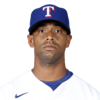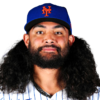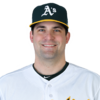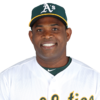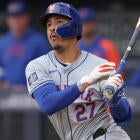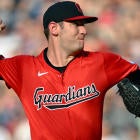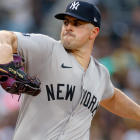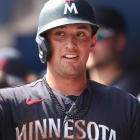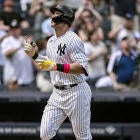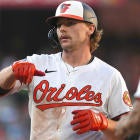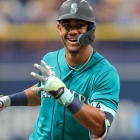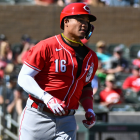Once upon a time, the Athletics' biggest concern was that Billy Beane's [stuff] didn't work in the playoffs. After consecutive 90-plus loss seasons, it might be fair to wonder if, at the nadir of the Beane era, their plan can work at all at this point.
OK, that probably isn't fair. Beane's A's averaged 93 wins in the three seasons prior to this most recent stretch, so we probably shouldn't overreact here. Still, things aren't looking great in Oakland for a third consecutive year, and they haven't committed fully enough to their rebuild to really stockpile big assets. The Athletics aren't quite young enough to be as bad as they are likely to be this coming season.
However, there are real reasons to be optimistic, especially on the pitching side of the ball. The offense has a real Island of Misfit Toys feel -- at least until Franklin Barreto gets the call -- but there are real reasons for optimism in the pitching staff.
Even if Sonny Gray doesn't bounce back, the next successful version of the A's is probably going to feature names like Sean Manaea, Jharel Cotton and Andrew Triggs. Toss in guys in the minors like Daniel Gossett, Grant Holmes and A.J. Puk, who could be in the majors within the next year or so, and the arms highlight this system, both in the majors and among the potential call-ups.
| 1 |
Rajai Davis
CF
|
| 2 | |
| 3 |
Ryon Healy
DH
|
| 4 |
Khris Davis
LF
|
| 5 | |
| 6 | |
| 7 |
Matt Joyce
RF
|
| 8 | 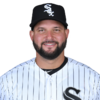
Yonder Alonso
1B
|
| 9 |
Jed Lowrie
2B
|
| Bench | |
| Bench |
Mark Canha
1B/OF
|
| 1 |
Sonny Gray
RHP
|
| 2 |
Sean Manaea
LHP
|
| 3 |
Kendall Graveman
RHP
|
| 4 |
Andrew Triggs
RHP
|
| 5 |
Jharel Cotton
RHP
|
| Alt SP |
Jesse Hahn
RHP
|
| Closer |
Ryan Madson
RHP
|
| Setup |
Ryan Dull
RHP
|
| Relief |
Santiago Casilla
RHP
|
| Relief |
Sean Doolittle
LHP
|
| Relief |
Frankie Montas
RHP
|
Can Sonny Gray bounce back from his disastrous season?
There may be no better example of how unpredictable pitchers are than Sonny Gray in 2016. In two and a half seasons in the majors, he had established himself as a model of consistency, posting between a 2.67 and 3.08 ERA, with a WHIP between 1.192 and 1.082. Gray even won 14 games in each of his two full seasons, with nearly identical strikeout and walk ratios. If you could predict any pitcher in 2016, it should have been Gray.
Of course, Gray stumbled badly last season, posting a 5.69 ERA in 117 innings of work before a forearm injury in the summer essentially ended his season. The funny thing is when Gray threw the ball, the results were largely the same as in previous seasons -- he struck out 7.2 batters per nine, while walking 3.2, with barely any drop in his average fastball velocity. The problems came when batters made contact, something they tended to do with quite a bit of force last season.
Gray was certainly a worse pitcher in 2016 than ever before, as evidenced by his 4.67 FIP, but there are at least some reasons to be optimistic about a bounceback. The forearm troubles are always a red flag, and you have to put a steep discount on his price tag on Draft Day. However, if you can snag him in the 12-15th-round range, he can definitely be a value.
How good can the young pitchers be?
The top pitching prospects in the A's organization are probably still a year or so away at best, but they've got some pretty interesting young guys set to open 2016 in the rotation, and there could be plenty of value here for Fantasy players.
The most obvious name is Sean Manaea, who already found success in the majors last season. As a 24-year-old, he posted a 3.86 ERA with solid peripherals, but really found his way in the second half when he lowered that ERA to 2.67, with 8.0 strikeouts per nine innings over his final 13 games. Manaea should be one of your favorite breakout candidates this coming offseason.
The other two young guys set to open the season in Oakland's rotation who should be on your radar are Andrew Triggs and Jharel Cotton. Cotton impressed in a cup of coffee last season, posting a 2.15 ERA in five starts, after sporting a 2.82 ERA at Triple-A Nashville following a trade to the A's. His overall Triple-A track record isn't quite as impressive because he had trouble keeping the ball in the yard. That isn't surprising given his reliance on a fastball-changeup combination, but playing in Oakland could help limit his worst tendencies. Cotton's ultimate fate might be a career like Rubby de la Rosa, another fastball-changup pitcher whose homer issues limited his effectiveness, but he'll have a chance to dodge that outcome in the O.Co Colliseum.
As a converted reliever with a middling fastball and a 4.31 ERA in his major-league time last season, Triggs is a less obviously impressive option than Cotton. However, during a four-start stretch late last season, he did strike out 20 batters in 21 2/3 innings with just one walk, and showed the ability to pitch effectively even while getting his count up into the high 80's. Triggs isn't an obvious mixed-league candidate, but he's an interesting sleeper, especially in that park.
Was Ryon Healy's 2016 for real?
No.
OK, my editor is saying I have to write more than that, so here goes:
There is a lot flukey about what Healy did in 72 games with the Athletics last season. We can start with the .352 BABIP and move along to a 16.0 HR/FB ratio while playing his home games in a canyon -- his 30.0 percent hard-hit rate hardly screams huge power threat either. Healy's Isolated slugging percentage was higher in his major-league stint than any full min0r-league campaign, so there's plenty of reason to expect regression there.
However, there is still room for Healy to be a useful Fantasy option even if -- when? -- he does regress. For one thing, he was a solid power threat in the minors, with averages of 37.8 doubles and 17.4 home runs per-150 games over his last three seasons. He did that while recording a strikeout rate of just 15.6 percent, so there's a chance Healy can be a high-average power threat, which is always nice. Still, he might be more of a 15-homer guy, and playing in that lineup and park will drive his counting stats down, so Healy might still be a relatively low-floor breakout candidate.





